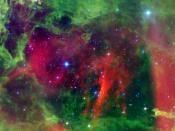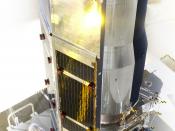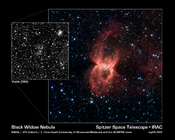In the constellation Circinus, where previous visible-light observations by the Digital Sky Survey (left) saw only a faint hourg lass-shaped patch of obscuring dust and gas, NASA's Spitzer Space Telescope's dust-piercing eyes see a big "Black Widow Nebula" teeming with clusters of massive young stars (right).
In the Spitzer image, the two opposing bubbles are being formed in opposite directions by the powerful outflows from massive groups of forming stars. The baby stars can be seen as specks of yellow where the two bubbles overlap.
When individual stars form from molecular clouds of gas and dust they produce intense radiation and very strong particle winds. Both the radiation and the stellar winds blow the dust outward from the star creating a cavity or, bubble.
In the case of the Black Widow Nebula, astronomers suspect that a large cloud of gas and dust condensed to create multiple clusters of massive star formation.
The combined winds from these groups of large stars probably blew out bubbles into the direction of least resistance, forming a double bubble.
The infrared image was captured by the Galactic Legacy Infrared Mid-Plane Survey Extraordinaire (GLIMPSE) Legacy project. The Spitzer picture is a four-channel false-color composite, showing emission from wavelengths of 3.6 microns (blue), 4.5 microns (green), 5.8 microns (orange) and 8.0 microns (red).
Science fiction is a narrative (usually in prose) or a short story, 'novella' or novel length. As to what it is about, is not easily classificable. Such stories are about an amazing variety of things, topics and ideas. But in general these ideas are related to the field of science.
The premodern science fiction were about journey to new lands, and some are also related to industrial revolution --- to the new developed machines --- which were to be more specific were not...


